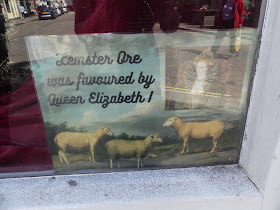The Herefordshire Oak seen from the caravan. Still green by the look of it.
On Friday before going to Stockton Bury Gardens we popped into Leominster as D had a cheque to pay into the bank and all the local branches near home seem to have closed!
Sheep made by children I think by the car park to celebrate the Queen's Jubilee.
I finally went into the bookshop. There is a great selection of local books including some by the super Logaston Press. There were two I was very tempted by one on Herefordshire Geology and one on Marcher Lords. I resisted as I have 3 or 4 at the caravan still to read - two of which I bought at Aardvark books.
David popped into the greengrocers to get some garlic to use for the tea and also bought two marrows so I could bake Stuffed Marrow with Tomato sauce when we got home.
Model of the Grange - somehow I've missed this on previous visits.
These little homemade glass suncatchers caught my eye. I may be tempted again next visit!!!
We checked the river by the car park for Kingfishers but no sign of one this time. It is B who always seems to spot them!
We then spent a couple of hours at Stockton Bury Gardens (see last post) where I read that one of the possible places where Owain Glyndwr, last Welsh Prince of Wales, (c1359 - c1415) may be buried was at Kimbolton Church.
So a slight detour was taken to the church.
On September 16th 1400 Owain had started the Welsh Revolt against the reign of Henry IV of England. He was proclaimed Prince of Wales by his supporters. The revolt began succesfully but was eventually put down. After the final battle of the Revolt in 1412 Owain Glyndwr disappeared without trace. Some historians thought he died in 1421.
One idea suggests he spent the last few years of his life, as a chaplain and tutor at his daughter Alys' estate in Herefordshire. She was married to Sir Henry Scudamore, the sheriff of the County.
One rumour suggests Owain was buried in a mound at Mornington Straddle.
However, Historian Gruffydd Aled Williams suggested in 2017 that the burial site is the chapel at Kimbolton - now the Parish Church of St James the Great - which was once a chapelry of Leominster Priory. He based his suggestion on manuscripts found in the National Archives. Kimbolton does have connections with the Scudamore family.
But, of course, no-one knows where he is actually buried.
St James the Great has a Norman chancel and the rest of the building is mainly C13th. There is an unbuttressed west tower with a tall broach spire. The church was restored by Haddon in 1874/5. The church appears to be normally open but is closed all August for repainting of the chancel!
I drove back to Hatfield via Leysters. Some of you may recall that twice before I have tried to find the Poet's Stone there where William Wordsworth and his wife Mary sat in 1845. The first two occasions were unsuccessful as it turned out to be further away from Leysters church than I realised! Today, really thanks to D who spotted it, we were successful. The stone was also visited by the Victorian Diarist Francis Kilvert.
We came home at lunchtime the following day but we did stop off at Brockhampton as D wanted to see the manor house and gatehouse there so I'll write about that in the final post of this break.
I hope everyone is staying safe and well.
Reference: Buildings of England: Herefordshire by N Pevsner and A Brooks 2017 Yale University Press.
BBC Wales History website














































































































